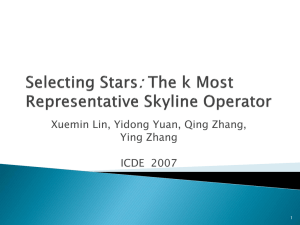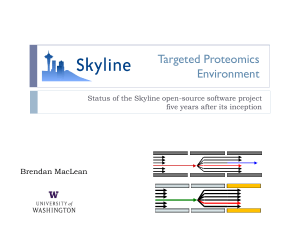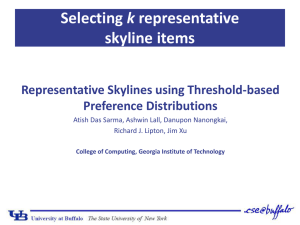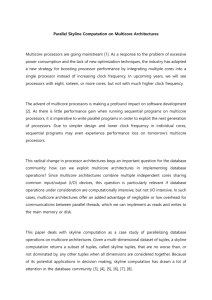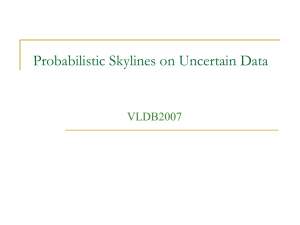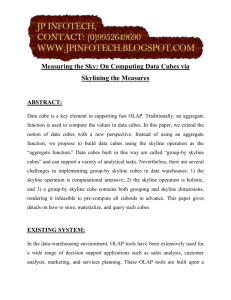On Skyline Groups
advertisement
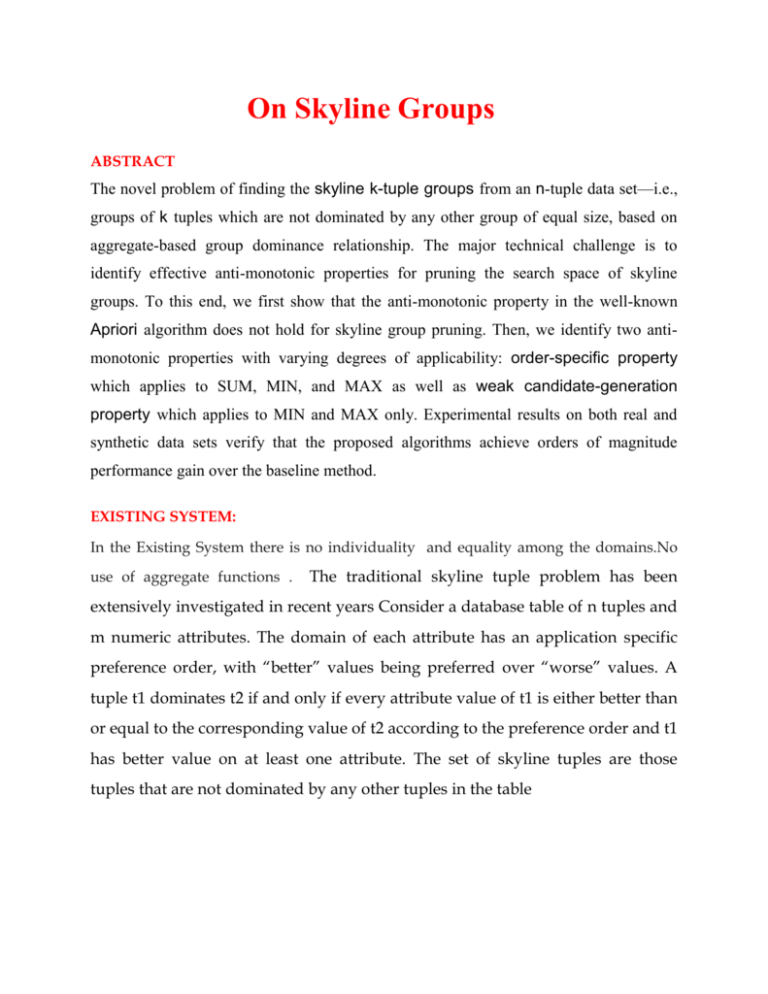
On Skyline Groups ABSTRACT The novel problem of finding the skyline k-tuple groups from an n-tuple data set—i.e., groups of k tuples which are not dominated by any other group of equal size, based on aggregate-based group dominance relationship. The major technical challenge is to identify effective anti-monotonic properties for pruning the search space of skyline groups. To this end, we first show that the anti-monotonic property in the well-known Apriori algorithm does not hold for skyline group pruning. Then, we identify two antimonotonic properties with varying degrees of applicability: order-specific property which applies to SUM, MIN, and MAX as well as weak candidate-generation property which applies to MIN and MAX only. Experimental results on both real and synthetic data sets verify that the proposed algorithms achieve orders of magnitude performance gain over the baseline method. EXISTING SYSTEM: In the Existing System there is no individuality and equality among the domains.No use of aggregate functions . The traditional skyline tuple problem has been extensively investigated in recent years Consider a database table of n tuples and m numeric attributes. The domain of each attribute has an application specific preference order, with “better” values being preferred over “worse” values. A tuple t1 dominates t2 if and only if every attribute value of t1 is either better than or equal to the corresponding value of t2 according to the preference order and t1 has better value on at least one attribute. The set of skyline tuples are those tuples that are not dominated by any other tuples in the table PROPOSED SYSTEM: In the Proposed System the main theme is to increase the output of the domain which is present in the skyline groups. Skyline group nothing but it is a data base stores information about some particular domains these domains will considered as tuples. Each tuple can maintain individuality .No domain can never dominate another. In this novel model by using aggregate functions easily will determine the output of the particular domain whether the output is minimized or maximized. Here five aggregate functions used such as sum, avg , max, min, count . In skyline groups all the domains should follow the antimonotonic properties . Advantage: • Maximizing the final outcome of the particular domain and maintain the equality among the groups. increasing the performance of domain. Features: 1. In this On Skyline Groups project the domainas will stored in a data base, and the domains should maintain individuality and equality. 2. PROBLEM STATEMENT: The problem of subspace skyline analysis. Skylines in subspaces can be concisely summarized by skyline groups. Skylines in subspaces can be concisely summarized by skyline groups. The representatives in skyline groups. They catch the “contour” of the skylines. SCOPE: The theoretical intractability, finding all skyline groups matching a MAX skyline vector v is usually efficient in practice. This is mainly because the number of tipples that “hit” the MAX attribute values in v is typically small. As such, even a brute-force enumeration can be efficient, as demonstrated by experimental results in Nonetheless, when a large number of tuples “hit” the MAX attribute values, it is unclear how one can efficiently find and store all skyline groups—e.g., by using certain efficient indexing schemes. We leave the design of such indexing schemes as an open problem for future research. PROCESS: MODULE DESCRIPTION: Number of Modules After careful analysis the system has been identified to have the following modules: 1. Skyline Queries 2. Skyline Groups 3. Dynamic Programming Algorithm Based on Order-Specific Property 1. Skyline Queries: Sky line is set of tuples of information. Skyline is defind as those points which are not dominated by any other point. A point dominates another point if it is good or better in all dimension and better in atleast one dimension. Skyline queries are a popular way to obtain preferred answers from the database by providing only the order ings of attribute values. 2. Skyline Groups: A multi-dimensional dataset of tuples skyline computation returns a subset of tuples that are not dominated by any other when all domains are considered together Conventional skyline computation, however, is inadequate to answer various queries that need to analyze not just individual tuples of a dataset but also their combinations. we study group skyline computation which is based on the notion of dominance relation between groups of the same number of tuples. It determines the dominance relation between two groups by comparing their aggregate values such as sums or averages of elements of individual dimensions, and identifies a set of skyline groups that are not dominated by any other groups. 3. Dynamic Programming Algorithm: Dynamic programming is a method for solving complex problems by breaking them down into simpler subproblems. It is applicable to problems exhibiting the properties of overlapping sub problems and optimal substructure .The idea behind dynamic programming is quite simple. In general to solve a given problem, we need to solve different parts of the problem then combine the solutions of the subproblems to reach an overall solution. The dynamic programming approach seeks to solve each subproblem only once, thus reducing the number of computations: once the solution to a given subproblem has been computed, it is stored .The next time the same solution is needed, it is simply looked up. This approach is especially useful when the number of repeating subproblems grows exponentially as a function of the size of the input. Dynamic programming algorithms are used for optimization. SOFTWARE REQUIREMENTS: Operating System : Windows Technology : Java and J2EE Web Technologies : Html, JavaScript, CSS IDE : My Eclipse Web Server : Tomcat Tool kit : Android Phone Database : My SQL Java Version : J2SDK1.5 HARDWARE REQUIREMENTS: Hardware : Pentium Speed : 1.1 GHz RAM : 1GB Hard Disk : 20 GB Floppy Drive : 1.44 MB Key Board : Standard Windows Keyboard Mouse : Two or Three Button Mouse Monitor : SVGA CONCLUSION: We proposed the novel problem of finding skyline groups which lends itself to many real-world applications. We developed novel algorithmic techniques on output compression, input pruning, and search space pruning to address the problem. For search space pruning, we identified a number of anti-monotonic properties to efficiently remove non-skyline groups from consideration. Based on the properties, we developed dynamic programming and iterative algorithms for skyline group search.Experimental results on real and synthetic data sets verify that the proposed algorithms achieve orders of magnitude performance gain over the baseline method.
